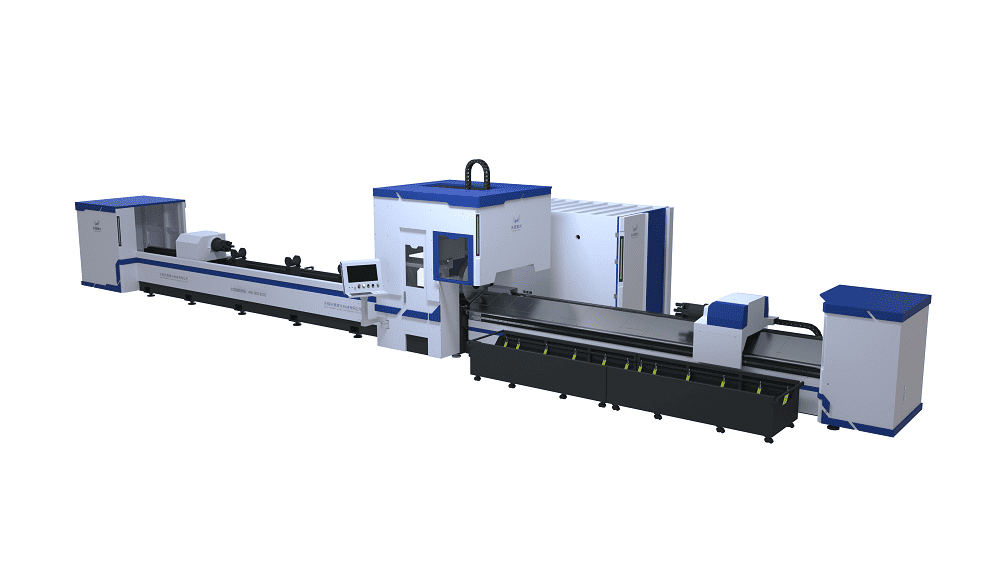
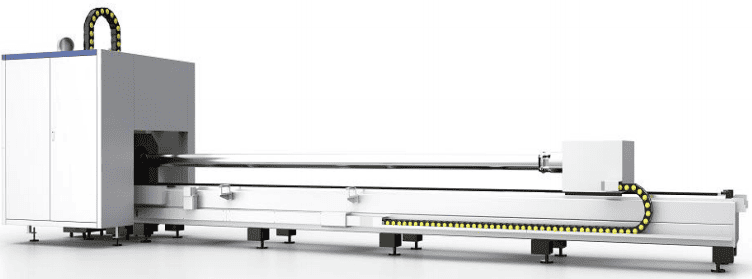
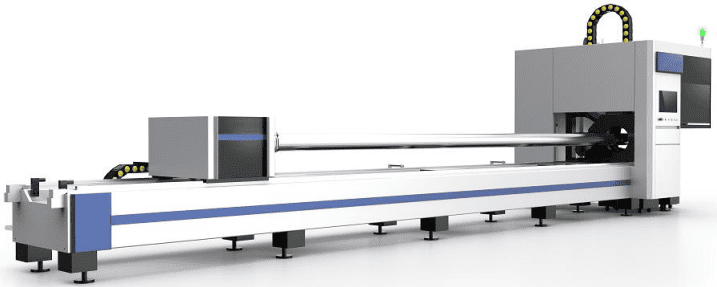
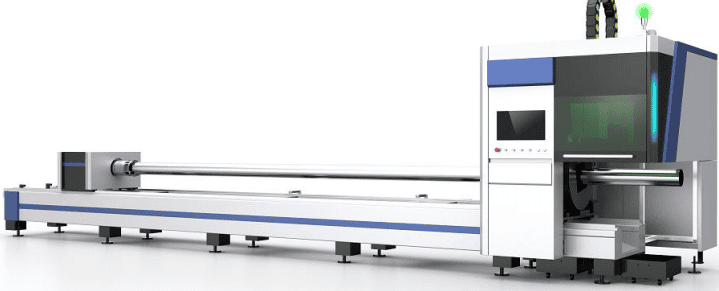

Tube Laser Cutting Machine
Qingyuan Laser, also known as Cheeron Laser, is recognized as one of the top ten manufacturers in China, specializing exclusively in fiber laser cutting machines since 2008. Their focus on this technology has led to a high level of expertise and professionalism in the field.
Qingyuan Laser offers a range of tube laser cutting machines, which are part of their extensive product lineup. These machines are designed for high precision and efficiency in cutting various types of tubes and pipes. The company’s experience, spanning over a decade, ensures that their machines are both reliable and advanced in technology.
Product Parameter
Laser Type | IPG |
Cutting Head | Raytools |
Water chiller | Hanli |
Follower sensing system | High precision automatic induction, accuracy ±0.1mm |
Driving system | Germany ROR rack (helical teeth) |
Rack & Pinion | ROR(Germany) |
Button Module | Schneider(France) |
AC Contactor | Schneider(France) |
X, Y axial guide rail | PMI |
Control system | Cypcut FScut((support English language, file formate .dxf, PLT, Gerber, AI and so on)) |
PC System | NODKA |
X axis servo | Fuji |
Y axis servo | Fuji |
Z axis servo | Fuji |
W axis servo | Fuji |
Power supply | Three-phase five-wire AC 380V±5%, 50Hz±1% |
Maximum cutting thickness | ≤10mm(carbon steel tube)Oxygen purity above 99.95% ≤5mm(stainless steel tube)Nitrogen purity above 99.999% |
Tube material | Round tube: inner wall diameter 20mm – outer wall diameter 219mm Square tube: inner wall length 20mm – outer wall length 150mm Pipe wall thickness ≥1mm |
Table | table frame welded table frame, strictly treated with hardening, tempering treatment to ensure no deformation during long time production |
Fiber Laser Cutting Machine With Exchange Table Video
Why Choose Us
- Professional design team provides customized services
- Production line with strict control process
- Fine processing technology
- Can meet the electrical standards of different countries
- Arrange on-site installation, commissioning, training, maintenance and other services within 7 days
- Trial operation will be carried out before delivery to ensure that the goods can be operated normally when they arrive at the customer
- Remote video guidance service available
Customer Site
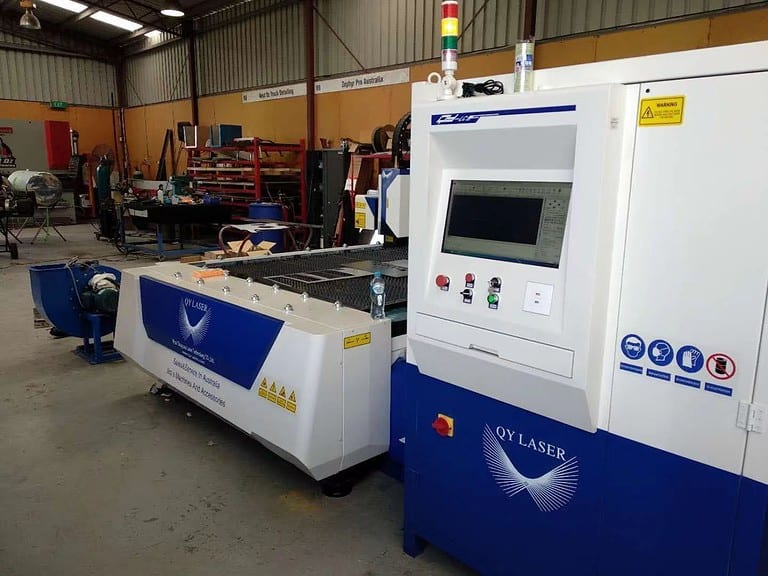
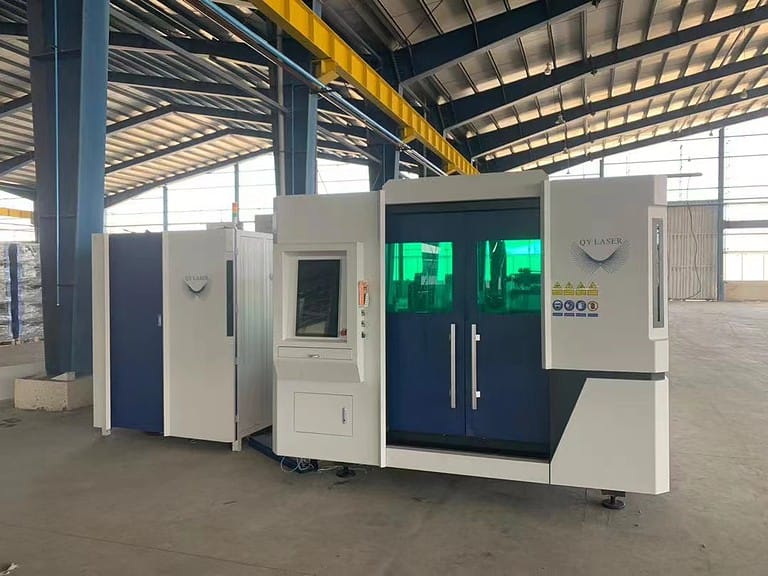
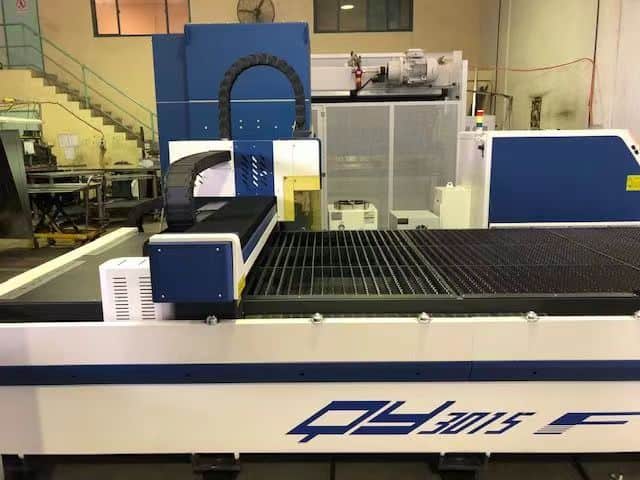
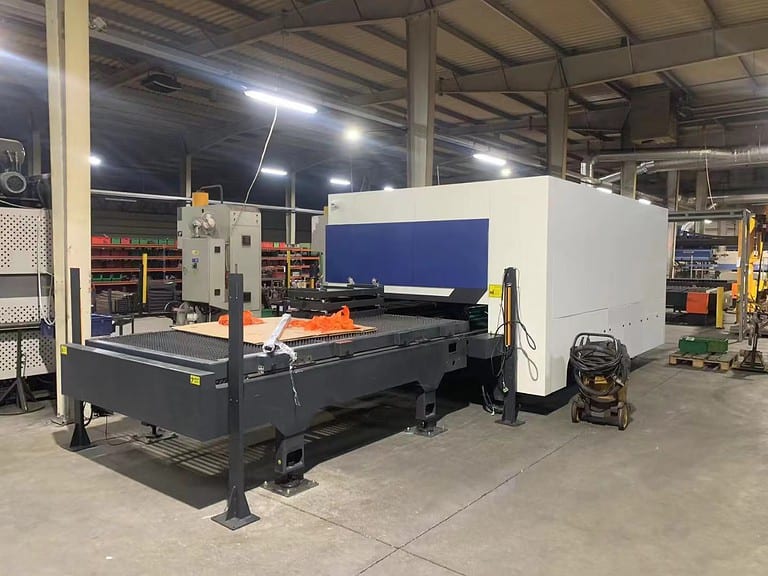

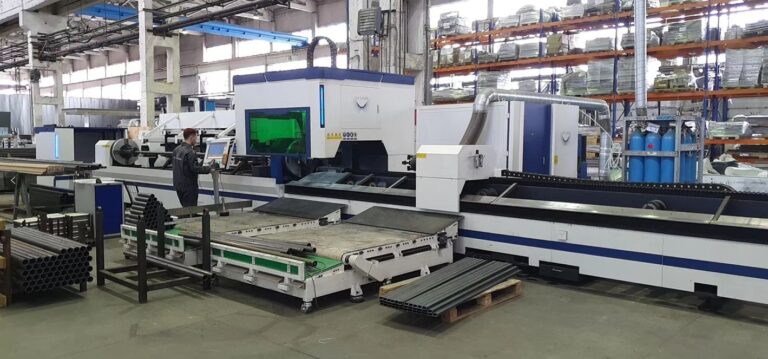
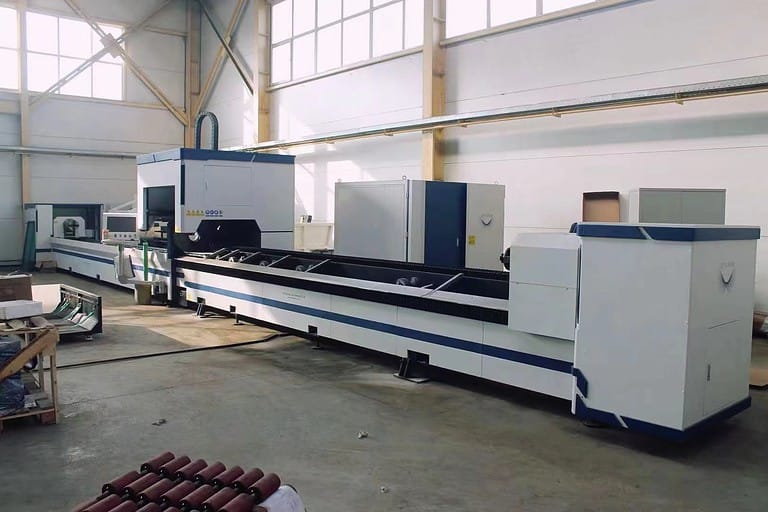
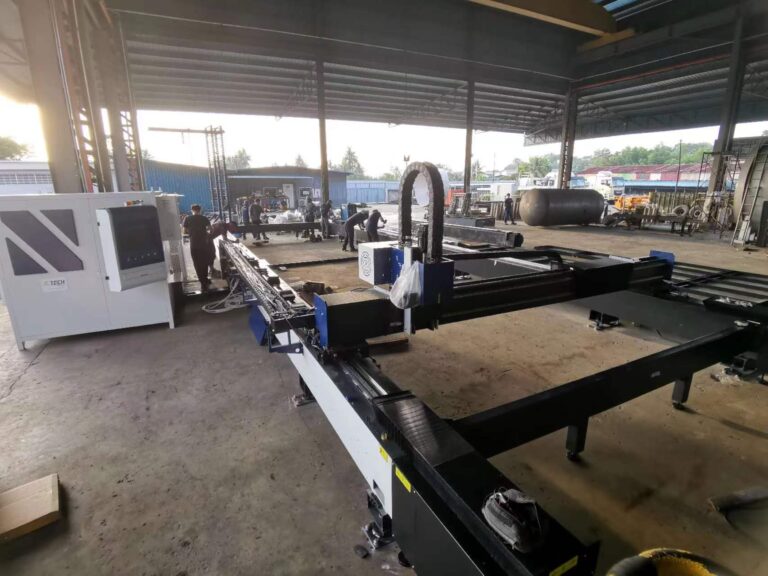
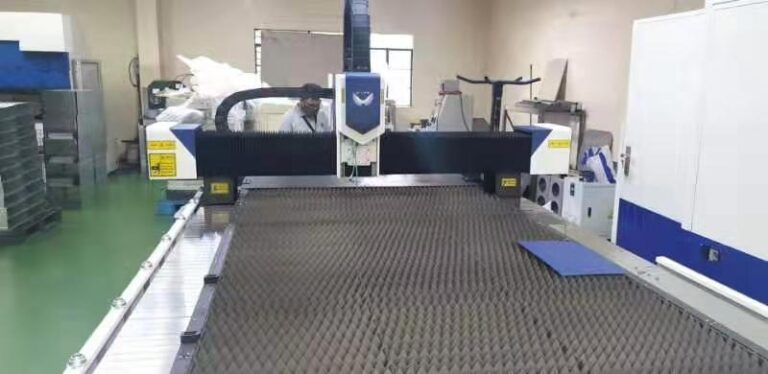
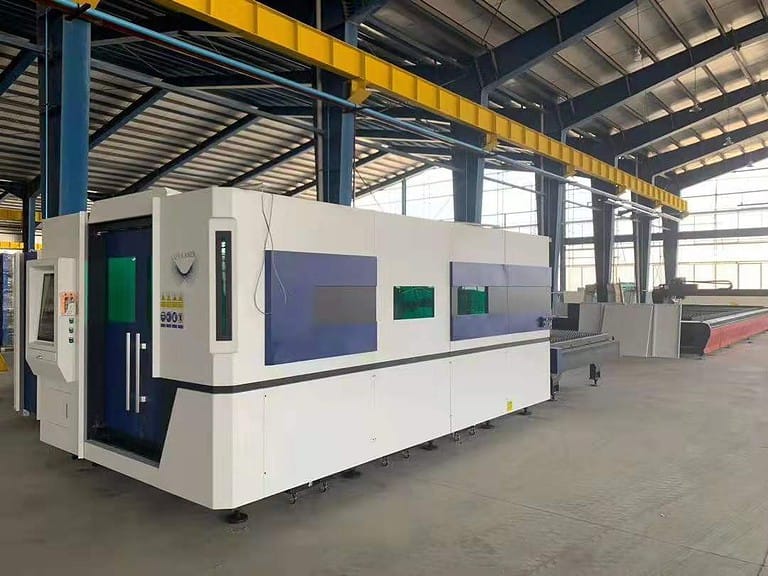

Machine Delivery
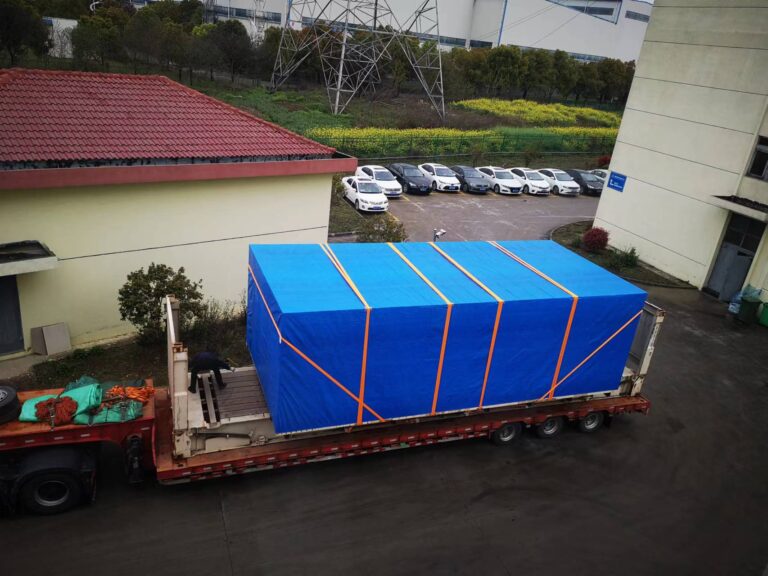



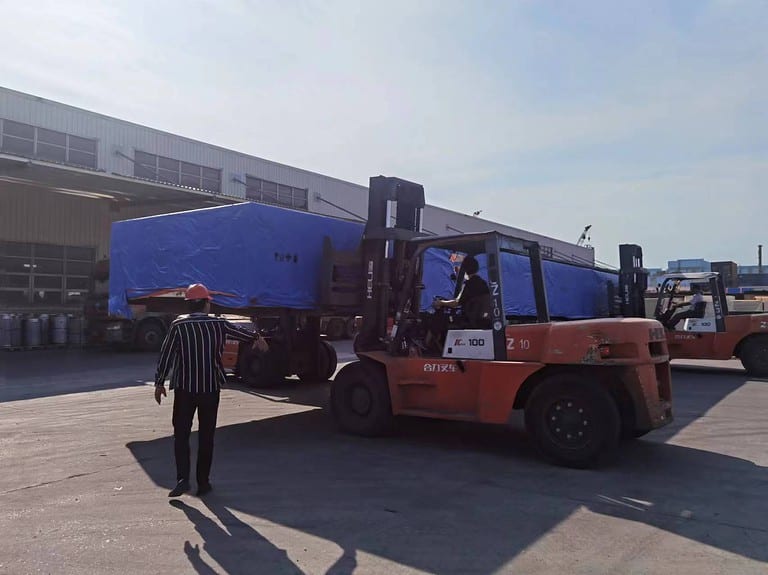
Key Features and Products
Automatic 2 Chuck Metal Round/Square Tube/Pipe Fiber Laser Cutting Machine: This machine is designed for automatic cutting of metal tubes and pipes, providing high precision and efficiency.
12m Heavy Tube Laser Cutting Machine With 520mm 4 Chucks: Suitable for longer and heavier tubes, this machine offers extended capabilities with its large size and multiple chucks.
Experience and Expertise: With over 10 years of experience in laser cutting machine production, Qingyuan Laser boasts a strong and professional R&D team, consisting of 52 high technical engineers.
Production Capacity and Quality: The company operates a high-level professional factory with over 30,000 square meters of space and maintains a production capacity with an output value above US$10 Million. This scale ensures the delivery of high-quality products and superb technology.
After-sales Services: Qingyuan Laser is committed to providing technical guidance and support, ensuring that their customers receive the necessary assistance for their machines.
Exploring Laser Tube Cutters: An In-Depth Guide
Meta Description: Unlock the secrets of laser tube cutters with this extensive guide. Learn about their functions, applications, advantages, and maintenance. Ideal for industry professionals seeking to optimize precision and efficiency in manufacturing.
Introduction
The advent of laser tube cutters has revolutionized industrial manufacturing, offering unparalleled precision and efficiency. These cutting-edge machines harness the power of laser technology to perform precise cuts on tubular materials, a task that once required time-consuming and less accurate methods. Their introduction has not only streamlined production processes but also expanded the possibilities in design and manufacturing. This guide aims to demystify laser tube cutters, delving into their functions, applications, advantages, and maintenance, making it an essential resource for professionals in the field, as well as for enthusiasts and newcomers eager to understand this transformative technology.
What is a Laser Tube Cutter?
A laser tube cutter is a sophisticated piece of machinery designed for precision cutting of tubular materials. It utilizes a high-powered laser beam to make accurate cuts, providing a level of precision that is unattainable with conventional cutting methods. This technology is especially valuable in industries where accuracy is paramount, such as automotive, aerospace, and construction.
What are the Key Features of a Laser Tube Cutter?
The key features of a laser tube cutter include:
- High-Precision Cutting: The ability to make extremely accurate and clean cuts.
- Programmable Cutting Patterns: Flexibility to perform complex cuts based on computer-aided designs.
- Fast Processing Speeds: Quick cutting processes compared to traditional methods.
- Versatility in Materials: Capable of handling a variety of materials and tube dimensions.
- Advanced Models: Some models come with 3D cutting capabilities and automated loading systems, enhancing efficiency and capability.
What is Laser Tube Cutting and Its Machine?
Laser tube cutting is a process that involves using a laser to precisely cut tubes or hollow structural sections. This method is highly favored for its ability to produce complex cuts with high precision, making it an indispensable tool in various manufacturing processes. The machines used, known as laser tube cutting machines, are CNC-controlled and feature a high-powered laser, adaptable for various materials and designs. It utilizes laser technology to cut and engrave tubes, offering remarkable precision. These machines are commonly used in manufacturing settings where intricate cuts and patterns are required on tube surfaces.
What is the Purpose of a Laser Cutting Machine?
The primary purpose of a laser cutting machine is to facilitate highly accurate and efficient cutting and engraving of tubular materials. This technology is indispensable in various manufacturing sectors, particularly where precision and intricate detailing are paramount. Key areas of application include:
- Precision in Manufacturing: In industries such as automotive and machinery production, laser cutting machines are crucial for creating detailed parts with exact measurements.
- Efficient Production: These machines significantly reduce the time needed for cutting processes, increasing overall production efficiency.
- Versatility in Design: Laser cutters are not limited to straightforward cuts; they can execute complex designs, making them suitable for artistic metalworking and custom designs.
- Material Flexibility: They are adept at handling a range of materials, from metals to certain non-metals, providing a one-stop solution for diverse cutting needs.
What are the Primary Applications of a Laser Tube Cutter?
Laser tube cutters are highly versatile tools used in a variety of industries, each benefiting from their precision and efficiency in cutting tubular materials. The primary applications of these machines span across multiple sectors, demonstrating their adaptability and importance in modern manufacturing and design:
- Automotive Manufacturing: In this industry, laser tube cutters play a critical role in fabricating complex components, such as exhaust systems and chassis parts. Their precision allows for the creation of parts that fit perfectly, a crucial factor in automotive assembly. The ability to handle high-strength materials and perform intricate cuts makes these machines invaluable in producing reliable and high-quality automotive components.
- Aerospace Industry: Here, laser cutters are used for cutting lightweight yet high-strength materials essential for aircraft manufacturing. The precision of laser cutting is vital for ensuring the safety and integrity of aircraft parts. These cutters can handle the unique shapes and sizes required in aerospace components, contributing to the innovation and efficiency of the industry.
- Construction: Laser tube cutters are employed in the construction sector for the precise cutting of structural elements. They are used to shape metal beams, pipes, and other structural components with high accuracy, ensuring the structural integrity and aesthetic appeal of buildings and infrastructures.
- Metalworking Art: Artists and designers frequently use laser tube cutters to bring intricate designs to life in sculptures and decorative metal pieces. The ability to execute complex and detailed cuts allows artists to push the boundaries of metalworking, creating unique and intricate artworks.
- Fitness Equipment: In the manufacturing of gym machinery and bicycles, laser tube cutters are essential for cutting tubes to exact specifications. The precision and efficiency of these cutters ensure that the equipment is both safe and aesthetically pleasing, meeting the rigorous standards of the fitness industry.
In each of these applications, laser tube cutters stand out for their ability to handle complex cutting tasks with precision and efficiency, making them a key tool in the manufacturing and creative processes of these industries.
What Materials Can Be Cut with a Laser Tube Cutter?
Laser tube cutters are renowned for their versatility in handling a wide range of materials, making them indispensable in various industrial and creative applications. These machines can cut through both metals and non-metals with precision, catering to the diverse needs of different industries. Here are some of the key materials they can work with:
- Steel: A staple in many industries, steel is commonly cut using laser tube cutters. They are capable of slicing through different grades of steel, including stainless and carbon steel, with precision. This is crucial in automotive, construction, and heavy machinery manufacturing, where steel’s strength and durability are essential.
- Aluminum: Known for its lightweight yet strong properties, aluminum is another popular material for laser cutting. Laser tube cutters can handle various aluminum alloys, making clean and precise cuts. This is particularly important in the aerospace and automotive industries, where aluminum’s weight-to-strength ratio is highly valued.
- Copper: Although a challenging material due to its high thermal conductivity, copper can be effectively cut with advanced laser tube cutters. This is essential in electrical and electronic industries, where copper’s conductive properties are in high demand.
- Plastics: Laser tube cutters can also process various plastics, adapting to the specific melting points and properties of different types. This ability is crucial in industries like medical device manufacturing and consumer goods, where plastics are used for their versatility and cost-effectiveness.
- Composites: These materials, known for their combination of strength and lightness, can be precisely cut with laser tube cutters. This capability is vital in industries such as aerospace and automotive, where the unique properties of composites are leveraged for high-performance parts.
The ability to cut these materials with precision and efficiency underscores the significance of laser tube cutters in modern manufacturing and design. Their adaptability across different materials opens up a wide array of applications, making them a key asset in various industrial processes.
What are the Maximum Dimensions and Thicknesses of Tubes that the Cutter Can Handle?
The capacity of a laser tube cutter to handle various dimensions and thicknesses of tubes is a crucial factor in determining its suitability for different applications. While this capacity varies depending on the specific model and make of the cutter, advanced machines are designed to accommodate a wide range of sizes and thicknesses. Here’s a closer look at the typical capabilities:
- Handling Long Tubes: Some high-end laser tube cutters are capable of processing tubes that are several meters in length. This feature is particularly beneficial for industries like construction and shipbuilding, where long metal tubes are a common requirement. The ability to handle long tubes reduces the need for joining smaller sections, thereby enhancing structural integrity and reducing labor.
- Accommodating Large Diameters: Advanced cutters can manage tubes with diameters spanning several inches. This capability is essential in industries such as oil and gas, where large-diameter pipes are used for transporting fluids. The precision of laser cutting ensures that these large tubes are cut accurately, which is crucial for maintaining the safety and efficiency of pipelines.
- Handling Various Wall Thicknesses: Laser tube cutters can work with tubes having a range of wall thicknesses. This flexibility is important in sectors like automotive manufacturing, where tubes of different thicknesses are used for various components. Thicker tubes might be used for structural elements, while thinner tubes could be employed in less load-bearing parts.
- Material Versatility: These cutters are not just limited by size but are also versatile in the types of materials they can handle, from thick steel for industrial use to lighter metals like aluminum for aerospace applications.
What are the Advantages and Disadvantages of Laser Tube Cutting Machines?
Laser tube cutting machines are revolutionizing the way industries handle the cutting of tubular materials, offering a blend of precision, speed, and versatility. While they bring numerous benefits to the table, there are also certain drawbacks that need consideration. Below is an elaboration of their advantages and disadvantages:
Advantages:
- High Precision: One of the most significant benefits of laser tube cutters is their ability to make extremely accurate cuts. This precision is crucial in industries like aerospace and automotive, where even a small error can have significant consequences. The laser’s ability to make clean, precise cuts ensures components fit together perfectly, reducing waste and enhancing product quality.
- Versatility: These machines can cut a variety of materials, including different metals and some non-metals, and can handle a range of thicknesses and tube sizes. This versatility makes them suitable for a wide array of applications, from industrial manufacturing to intricate artistic designs. For instance, in metalworking art, the ability to execute complex designs and patterns is particularly valuable.
- Speed: Compared to traditional cutting methods, laser cutters are much faster, significantly increasing production efficiency. In manufacturing settings where time is money, this speed translates to quicker turnaround times and higher output, thereby boosting productivity.
Disadvantages:
- Higher Initial Costs: One of the main drawbacks of laser tube cutting machines is their high initial investment cost. For small businesses or startups, this cost can be prohibitive. While the long-term benefits such as efficiency and precision can offset these costs, the upfront investment is still significant.
- Specific Safety Requirements: Operating a laser cutter involves strict safety protocols. The high-powered lasers can be hazardous if not handled correctly, necessitating proper training and safety measures. This includes protective gear for operators and adherence to safety standards, adding to the operational complexities.
- Energy Consumption: Laser cutters generally consume more energy compared to some traditional cutting methods, leading to higher operational costs. This aspect is particularly important for businesses focusing on energy efficiency and cost reduction.
Understanding these advantages and disadvantages is crucial for businesses and individuals considering the adoption of laser tube cutting technology, ensuring that they can make informed decisions based on their specific needs and capabilities.
What is the Cost Range and Factors for Different Types of Laser Tube Cutters?
The cost of laser tube cutters varies widely, reflecting the diversity in their capabilities and applications. Generally, prices can span from a few thousand dollars for more basic models to several hundred thousand for highly advanced systems. This variation in cost is influenced by several key factors:
- Size and Capacity: Larger machines with the capacity to handle bigger or longer tubes typically cost more. This is due to the increased material and technological requirements needed to sustain larger cutting operations. For instance, a machine capable of processing tubes several meters in length with greater diameters will be priced significantly higher than a smaller, more compact model.
- Precision and Complexity: The level of precision a machine can achieve affects its price. Higher precision models, which are essential for industries like aerospace and automotive manufacturing where even minute inaccuracies can be critical, are more expensive. These machines often incorporate more sophisticated technology to achieve such high levels of accuracy.
- Materials Handled: The types of materials a cutter can process also play a role in its cost. Machines designed to cut through tougher or more diverse materials, such as certain alloys or composites, require more advanced laser systems and cooling mechanisms, increasing the price.
- Additional Features: Features like 3D cutting capabilities, automated loading and unloading systems, and advanced software for design and programming can significantly increase the cost. For example, a laser tube cutter equipped with 3D cutting technology and an automated feed system will be more expensive than a standard 2D cutter with manual loading.
- Brand and After-Sales Service: The manufacturer’s brand and the level of after-sales service and support also factor into the cost. Renowned brands with a reputation for quality and robust customer support networks often price their machines higher, reflecting the added value of reliability and service.
Understanding these factors can help potential buyers make informed decisions based on their specific needs and budget. Whether for small-scale artistic endeavors or large-scale industrial manufacturing, there is a laser tube cutter available to meet the diverse requirements of different users.
How Does a Laser Tube Cutter Differ from a Traditional Tube Cutter?
Laser tube cutters represent a significant advancement over traditional tube cutters, offering enhanced capabilities in precision, design versatility, and speed. These modern cutters leverage laser technology to achieve results that are often unattainable with conventional mechanical cutting methods. Their unique features and benefits are highlighted in various aspects:
Enhanced Precision:
- Laser tube cutters use a focused laser beam for cutting, which allows for extremely accurate and clean cuts. This high level of precision is essential in industries like aerospace and automotive, where even the slightest deviation can compromise the integrity of a part.
- In automotive manufacturing, laser cutters are used to produce complex engine parts that require exact dimensions and fit.
Greater Versatility in Design:
- Unlike traditional cutters that are limited to simpler, straight cuts, laser cutters can handle intricate patterns and complex geometries. This flexibility opens up new possibilities in design and manufacturing.
- In the field of metal art, artists utilize laser cutters to create detailed and elaborate designs that would be difficult or impossible to achieve with mechanical cutters.
Faster Processing Times:
- Laser cutters operate at a much faster rate than traditional mechanical cutting methods. This speed is a significant advantage in mass production settings, where reducing the time per cut can lead to substantial increases in overall productivity.
- In the production of consumer electronics, where components need to be produced rapidly and in large quantities, laser cutters dramatically reduce the time taken per unit.
Reduced Material Wastage:
- The precision of laser cutters also means less material is wasted. This efficiency is not only cost-effective but also environmentally beneficial.
- In industries like shipbuilding, where large tubes and beams are cut, the reduction in material wastage can lead to significant savings and less environmental impact.
Better Quality of Cuts:
- The cuts made by laser cutters are generally cleaner, with smoother edges and less material distortion. This quality is crucial for finished products that require minimal post-processing.
- In the fabrication of medical devices, where smooth and clean cuts are essential for the safety and functionality of the devices, laser cutters provide the necessary quality.
Laser tube cutters, with their advanced technology, offer significant improvements over traditional mechanical tube cutters in terms of precision, design capabilities, speed, material efficiency, and cut quality. These advantages make them indispensable in modern manufacturing and creative processes.
How Does the Precision and Accuracy of a Laser Tube Cutter Compare to Other Cutting Methods?
The precision and accuracy of laser tube cutters are unparalleled when compared to other cutting methods such as plasma or water jet cutting. This superiority is particularly evident in tasks requiring intricate designs and fine details. Laser cutting stands out due to its:
- Exceptional Accuracy: Laser cutters offer extremely high precision, capable of making cuts with minute tolerances. This accuracy is crucial in industries where even a small deviation can compromise the functionality or safety of a part.
- Intricate Design Capability: In the creation of complex geometric patterns or detailed artistic designs, laser cutters can produce shapes and patterns that would be nearly impossible with other methods. The focused laser beam can make very small, intricate cuts without damaging surrounding material, allowing for more complex and delicate designs.
- Smooth Edge Finish: When cutting metals for visible parts of consumer products, such as in electronics or appliances, the smooth edge finish provided by laser cutting is highly desirable. Unlike plasma cutting, which can leave rough or jagged edges, laser cutting melts and fuses the edges, resulting in a smooth, clean finish that often requires no further processing.
- Material Preservation: In industries like aerospace or medical devices, where material integrity is critical, laser cutting is advantageous. The localized heat impact of a laser minimizes the heat-affected zone, preserving the strength and integrity of the material around the cut.
- Reduced Material Waste: In mass production environments, such as automotive manufacturing, reducing waste is both cost-effective and environmentally friendly. Laser cutters can be programmed with optimized cutting patterns that maximize material use and minimize waste, an efficiency not as easily achieved with plasma or water jet cutting.
Overall, the precision and accuracy of laser tube cutters make them a preferred choice for a wide range of applications, especially where quality and detail are of the utmost importance.
What are the Safety Features Incorporated in Laser Tube Cutting?
Laser tube cutting, while highly efficient, involves the use of high-powered lasers that necessitate stringent safety measures. To ensure operator safety and prevent accidents, laser tube cutting machines are equipped with several built-in safety features. Each of these features plays a crucial role in creating a safe working environment:
- Protective Enclosures: These enclosures are designed to shield operators from direct exposure to the laser beam. They are typically made of materials that absorb or reflect the laser light, preventing any harmful radiation from escaping the cutting area. This is essential for protecting the eyes and skin of operators from the intense laser.
- Fume Extraction Systems: Laser cutting can produce fumes and particulate matter, which can be harmful if inhaled. Fume extraction systems are therefore essential. They work by ventilating the cutting area and filtering out harmful particles and gases, maintaining a safe air quality in the workspace.
- Emergency Stop Buttons: These are strategically placed on the machine to allow operators to quickly shut down the machine in case of an emergency. This immediate halt of operations can prevent accidents and equipment damage, ensuring a rapid response to any unforeseen issues.
- Safety Interlocks: Safety interlocks prevent the laser from operating when the machine’s doors or panels are open. This feature ensures that the laser can only be activated when all safety enclosures are securely closed, preventing accidental exposure to the laser beam.
- Regular Safety Training: While not a physical feature of the machine, ongoing safety training for operators is crucial. This training covers the proper operation of the machine, understanding of all safety features, and procedures to follow in case of an emergency.
- Automated Monitoring Systems: Some advanced laser cutters come with automated monitoring systems that continuously check the machine’s operating status. These systems can detect potential safety hazards, such as overheating or mechanical failures, and automatically shut down the machine to prevent accidents.
Each of these safety features contributes to a secure operating environment, minimizing the risk of accidents and health hazards associated with laser tube cutting. It’s a combination of technology and operator awareness that ensures the safe use of these powerful machines.
How Does the Laser Tube Cutter Handle Complex Cuts or Designs?
Laser tube cutters excel in handling complex cuts and designs, thanks to the integration of advanced software and CNC (Computer Numerical Control) technology. This combination allows for the execution of intricate and precise cutting patterns that are difficult to achieve with traditional cutting methods. The process starts with detailed designs, often developed in CAD (Computer-Aided Design) software, encompassing complex geometries, detailed art, or precise engineering specifications. Once these designs are finalized, they are input into the laser cutter’s control system. The CNC technology translates these digital designs into accurate cutting instructions, directing the laser beam with exceptional precision along the complex paths of the design.
This high level of control enables laser tube cutters to produce detailed cuts with sharp angles, intricate curves, and complex patterns. The laser’s focused beam is capable of targeting very small areas without affecting surrounding materials, leading to efficient material usage and minimal waste. This precision is particularly valuable in industries where maximizing material efficiency is essential, such as aerospace or automotive manufacturing. Additionally, the flexibility of laser tube cutters to work with various materials and thicknesses broadens their application scope, making them ideal for tasks ranging from crafting artistic metal sculptures to producing intricate mechanical components. This advanced functionality not only elevates the quality and complexity of the cuts but also fosters innovation and creativity across diverse fields.
What Type of Maintenance is Required for a Laser Tube Cutter?
Maintaining a laser tube cutter is crucial to ensure its longevity, optimal performance, and safety. Proper maintenance routines prevent downtime, extend the life of the machine, and ensure consistent cutting quality. Key aspects of maintenance include:
- Cleaning Lenses and Mirrors:
- Importance: These components are integral to the machine’s ability to focus and direct the laser beam accurately.
- Procedure: Regular cleaning with appropriate solutions and tools is necessary to remove dust, debris, and residues that can interfere with laser quality.
- Impact: Clean lenses and mirrors ensure a consistent, high-quality laser output, essential for precision cutting.
- Checking and Aligning Laser Beams:
- Importance: Proper alignment of the laser beam is crucial for achieving precise cuts and avoiding material wastage.
- Procedure: Regular checks and adjustments, often with the help of specialized calibration tools, ensure the laser beam is correctly aligned with the cutting path.
- Impact: This prevents deviations in cuts, which can compromise the quality and accuracy of the final product.
- Ensuring Smooth Motion of Mechanical Parts:
- Importance: The mechanical parts, like gears and rails, are responsible for the smooth movement and positioning of the laser head.
- Procedure: Regular lubrication and checking for wear and tear are essential. Parts should be replaced or repaired as needed to maintain optimal operation.
- Impact: Smooth operation of these parts is vital to prevent jerky movements which can lead to imprecise cuts and reduced machine efficiency.
- Inspecting Cooling Systems:
- Importance: Laser cutters generate significant heat, and a proper cooling system is vital to prevent overheating.
- Procedure: Regular inspection and cleaning of cooling systems, including filters and coolant levels, are necessary.
- Impact: A well-maintained cooling system ensures the laser operates at an optimal temperature, preventing heat-related damage and maintaining consistent cutting performance.
- Software Updates and Diagnostics:
- Importance: Keeping the software updated ensures compatibility with various design files and smooth operation of the CNC interface.
- Procedure: Regular software updates and running diagnostics can help identify and resolve potential issues before they become significant problems.
- Impact: Updated software enhances the cutter’s capabilities and reliability, ensuring efficient operation and minimizing downtime.
Adhering to these maintenance practices not only extends the life of the laser tube cutter but also ensures it operates at peak efficiency, producing consistently high-quality cuts while minimizing the risk of breakdowns and costly repairs.
What are the Common Problems and Troubleshooting Techniques for Laser Tube Cutters?
Laser tube cutters, while sophisticated and efficient, can encounter various issues during their operation. These problems can range from mechanical misalignments to software glitches, all of which can affect the machine’s performance and accuracy. Understanding these common issues and their troubleshooting techniques is crucial for maintaining the optimal functionality of the cutter. Some of the prevalent problems and their solutions include:
- Misalignment of the Laser:
- Problem: This occurs when the laser beam does not accurately align with the intended cutting path, leading to imprecise cuts.
- Solution: Regularly check and adjust the alignment of the laser. This may involve recalibrating the laser system and ensuring that all components are correctly aligned according to the manufacturer’s specifications.
- Inconsistent Cuts:
- Problem: This issue manifests as variations in cut quality or depth, often caused by uneven focus of the laser or wear and tear of components.
- Solution: Regular maintenance is key. This includes checking and replacing worn lenses or mirrors, ensuring consistent focus of the laser beam across different areas of the material, and maintaining a stable power supply.
- Software Errors:
- Problem: Software issues can lead to incorrect cutting patterns or machine malfunctions.
- Solution: Regular software updates and diagnostics are essential. Ensure that the software is up-to-date and correctly configured. In cases of errors, running diagnostic tools provided by the software or consulting with the manufacturer can be helpful.
- Poor Quality Cuts:
- Problem: Issues like rough edges or incomplete cuts can arise due to improper laser settings or material handling.
- Solution: Optimize the laser settings such as power, speed, and focus for the specific material being cut. Also, ensure that the material is properly secured and positioned for cutting.
- Overheating of the Machine:
- Problem: Prolonged use or inadequate cooling can lead to overheating, affecting performance.
- Solution: Ensure adequate cooling systems are in place and functioning correctly. Regular breaks during extensive cutting operations can also prevent overheating.
- Dust Accumulation:
- Problem: Dust and debris from cutting can accumulate on lenses and other parts, affecting the cutting quality.
- Solution: Implement a regular cleaning regimen for the machine, focusing on lenses, mirrors, and any areas where debris tends to accumulate.
By addressing these common problems with appropriate troubleshooting techniques, the longevity and efficiency of a laser tube cutter can be significantly enhanced, ensuring that it continues to perform at its best in various industrial and creative applications.
Conclusion
Laser tube cutters, a transformative technology in industrial manufacturing, offer unparalleled precision and efficiency, revolutionizing the processing of tubular materials in various sectors. These sophisticated machines, utilizing high-powered laser beams, excel in high-precision and clean cuts, programmable patterns, and quick processing speeds, handling a diverse range of materials, including different metals and plastics. Widely used in automotive, aerospace, construction, and artistic metalworking, they allow for intricate designs and complex cuts, essential for precision manufacturing and creative endeavors.
Despite their numerous advantages, such as speed and versatility, laser tube cutters come with higher initial costs, specific safety requirements, and higher energy consumption. Proper maintenance and adherence to safety protocols are paramount to ensure their longevity and optimal performance. In essence, laser tube cutters have become indispensable in modern manufacturing and design, reshaping how industries approach the cutting and shaping of tubular materials, and representing a significant leap in manufacturing technology with their unmatched precision and versatility.
